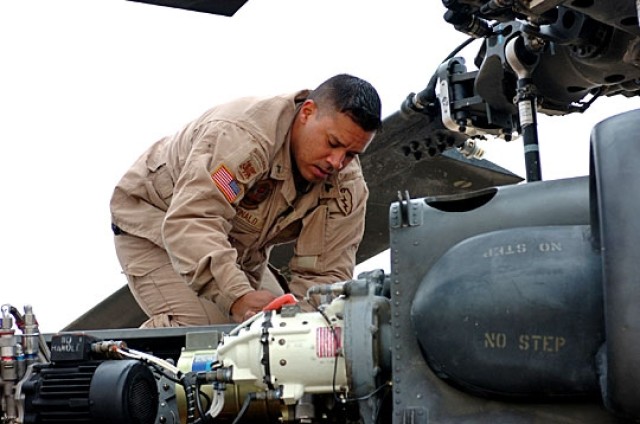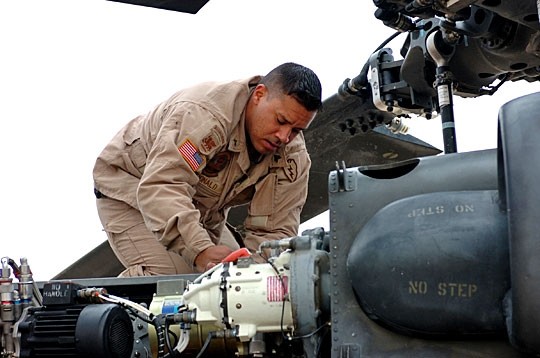
TIKRIT, Iraq, Feb. 8, 2007 - Just off the flight line at Contingency Operating Base Speicher, a coffee shop stands huddled with several other small buildings and tents in the shadow of a large hangar.
Inside, UH-60 Black Hawk pilots, crew chiefs and flight medics watch television, drink coffee and chat.
These men and women of the air ambulance company serving Multinational Division - North throughout northern Iraq appear at first glance to be enjoying time off. They are actually getting in what relaxation they can in the time between calls.
"Most of the day we try to relax, but when the call comes, we have to run at 100 percent," said Sgt. Nicholas Egbert, a flight medic with Company C, 3rd Battalion, 25th Aviation Regiment, 25th Combat Aviation Brigade, 25th Infantry Division.
The air ambulance company's primary job is to respond quickly whenever there is a call to evacuate or transport an injured person. From their base, they must fly to where the injured is, provide immediate care and perform life-saving measures until they can get him to the nearest medical facility.
The company must be on constant alert, ready to fly to wherever there are injured troops at a moment's notice.
"When on duty, you don't have the luxury of taking showers or even taking your uniform off," said Chief Warrant Officer 2 Jon-Glen Brown, a pilot with the company.
When a call comes in, the crew on duty has between 15 and 20 minutes to get in the air. In order to meet this stringent timeline, the crews are well-rehearsed in exactly what they have to do to get into the air.
"A good way to describe it would be coordinated chaos," said Pfc. Joseph Skorupski, a radio transmission operator for the company.
Once they get the medical evacuation request, the soldiers often have to change gears from a dead stop to full speed in order to get into the air in time.
"You're trying to get some sleep, you wake up, run as fast as you can and try to put your gear on," Egbert said. "Usually the crew chief will go out to get the aircraft ready while the medic and pilot in charge stay to get info from command post. Our goal is to be in the air in (less than) 10 minutes."
A lot has to happen in those 10 minutes though.
The pilots need to figure out where they are going and plot the best route there and the medic must get as much information about the injury as they can so they can make sure they bring the proper equipment.
While many of their patients are combat injuries, the air ambulance company works with a full range of patients - from a contractor who swallowed his dentures to the worst injuries that a combat zone can produce.
Staying focused in the short time before takeoff and while conducting the mission is one of the most difficult aspects of the job.
The soldiers have to be able to shut out any worries or concerns that could cause them to be less than focused on the task at hand.
"One thing about our job, it happens really quick," Brown said. "A cloud comes over and there's only the here and now. It's like a blanket falls over everything else in the world."
Part of staying focused is knowing their jobs in and out, and even a little of each other's jobs so that when they have to move quickly, they can perform their duties almost as a reflex.
The crew chiefs of each shift are responsible for making sure the aircraft are in a constant state of readiness. They check the helicopters' engines, structures and flight controls to ensure they are in working order.
The flight medics, aside from providing immediate care to their patients, must also learn some flight crew skills in order to assist the crew chief. Similarly, the crew chief may sometimes have to assist the medic with tending to a patient.
Meanwhile, it's the pilots job to get the aircraft to and from the patient's location as quickly and safely as possible.
"I know the limits of the aircraft, and it's my job to fly it as fast as it will go," Brown said. "If the medic's not talking to me - I need to fly faster."
Successfully completing their mission also requires fast and accurate coordination within their command post on COB Speicher. As conditions change, or more information becomes available, the unit's radio transmission operator has to keep the lines of communication open and organized.
A crucial part of the mission is for the radio operator to take in the information, organize it and push it back out to the people who need it, Skorupski said.
While their job is dangerous and hectic, the air ambulance soldiers find satisfaction in their work.
"We're in the business of saving lives," Brown said. "I don't think there's any higher calling."
"I just want to say how proud I am of this team for the missions they executed each day putting themselves in harm's way for the soldiers on the ground," said Maj. Pete Eberhardt, the company's commander. "The morale boost to the (soldier on the ground) is immeasurable. Every time the (Soldier on the ground) goes outside the wire, he is confident that we will [quickly] respond if he needs us."

Social Sharing